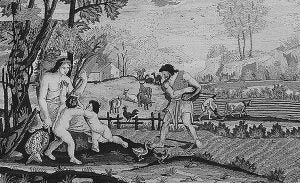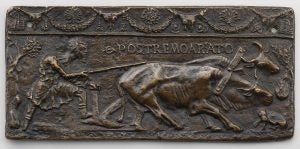For all the knowledge lost during the ‘Dark Ages,’ much agricultural technology survived to impact modern farming
Today’s ag world is full of cool tech, and it seems we are always looking toward tomorrow. But let’s slow down for a minute and appreciate some of our earliest roots that paved the way for all this, specifically a period of early European society. The time known as the Middle Ages is often generically called the “Dark Ages.” From the fall of the Western Roman Empire through the Renaissance or Age of Discovery (that’s approximately the 5th through 15th centuries), this wide bracket of time was long known more for being primitive and pitiful than as an infancy of ag technology.
But this role shouldn’t be under appreciated nor under estimated. After all, a society in which 80 percent to 90 percent of its civilians were directly involved in agriculture and food production is bound to develop a few ideas.
Before massive transportation and complex importation policies, a country relied on its entire agriculture sector to not only produce, but also process and store food to get through the harsh winter months. Failure wasn’t the collapse of a business or a single family, it could spell the destruction of a nation.
But as it pertains to what we have today, let’s think about the infantile machinery, equipment, and even agronomic practices that were put in place. Unknowingly, every day innovators were acting as spearheads of future agribusiness empires — before even the science or mechanics behind the scenes were fully understood.

Feeding the early world
While nutrition knowledge was primitive, there was no shortage of calories to keep the noble and working classes of European society up and functioning.
Diets were anything but structural, and essential nutrients were usually lacking, but there was plenty of energy to go around. The agrarian system focused on diets that were high in carbohydrates and protein. This is due to an emphasis on cereal grains, beer and livestock — all of which were easy to keep stored and preserved to last through extended harsh winters.
After the Black Plague, meat may have accounted for nearly a fifth of the average diet, with an estimated average caloric intake for working men as high as 3,000 calories!
Growing and increasingly centralized populations may have been a motivator to increase output and, slowly, move toward greater efficiency. More hands could preserve more food and produce more goods, but man hours alone weren’t enough to increase yields. It would take advancement of existing equipment to adequately fill that need.
Today’s innovations are yesterday’s ideas
Many of today’s basic tools and equipment have truly ancient roots. From the year 1000 to 1300 A.D., there was an exceptional growth in agriculture technologies, many of which were introduced to European societies from outside the continent, thanks to increasing transportation and connectivity between cultures. Among the most important of these innovations was the heavy plow. This was an improvement on the more primitive wooden “scratch plow” as used in ancient civilizations such as Egypt.
The concept of the heavy plow isn’t all that far off from today’s — an iron plowshare with a simple moldboard for full turnover and wheels for easy movement. This innovation allowed better aeration for the dense, sticky clay soil covering most of Europe and is often cited as being a big contributor to rising yields throughout the following centuries.
One study found after the heavy plow was introduced, regions with greater fertile clay soils saw an increase in urbanization. This is further evidence that, in the long-term, development depends heavily on agriculture advancement.
It should be noted, this was only possible with significant development of harnessing equipment. Most important is the padded horse collar still seen globally today. This simple invention was developed as early as the true Dark Ages (some say the 8th or 9th centuries), and widely adopted by the 12th century.
More agile than a team of oxen, horses could cover more land quickly. Unfortunately, the traditional Roman oxen yoke was incompatible with a horse’s anatomy.
The padded collar, however, allowed horses to pull significantly more weight with ease. Without it, the moldboard plow as we know it would never have seen the light of day.
Also notable was the rise of the traditional water mill. This isn’t entirely a Middle Ages invention; the Roman Empire was also revered for having such technology available to its massive citizenship. However, with the abundance of slave labor, hand milling was their preference.
As urbanization spread and free labor decreased, the European windmill rose to power in the 11th and 12th centuries, to the point these structures were common in nearly every region. This saved time, hard labor and made it possible to keep up with growing yields.

Farming throughout the year
Despite not having advanced meteorology at their disposal, peasant farmers made pretty good use of their seasonal calendar to make climate work to the advantage of their growing and harvest.
Late winter began the time of plowing and fertilizing, followed by planting in spring through early summer. Congruent to the growing and planting season was the laborious weed-pulling and bird-scaring essential to the later harvest.
In the “off season,” families were able to focus attention on other essential tasks, such as processing and refining goods like wool, straw, grain, and meat.
One cannot discuss early European agriculture without mentioning the development of the three-field system. While specific knowledge of soil health, fertilization, and agronomy was pretty basic, this methodology reflects what later generations were able to discover.
The three-field system allowed for a rotation of summer and winter crops, with overlapping growing seasons while one could go fallow for the full year. With a variety of staples that included beans, peas, and different small grains, this rotation was pretty effective maximizing soil nutrients.
While the rise of scientific discovery was yet to come, the long period that was the Middle Ages laid the necessary foundation for future innovators. The labor was mundane and agonizingly slow, but small changes made over the years kept societies alive and growing — ultimately to where we are today.
Jaclyn Krymowski is a recent graduate of The Ohio State University with a major in animal industries and minor in agriculture communications. She is an enthusiastic “agvocate,” professional freelance writer, and blogs at the-herdbook.com.



